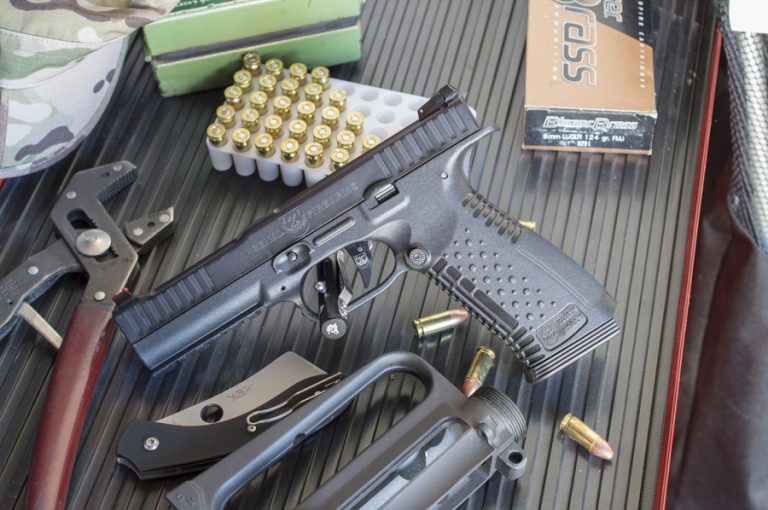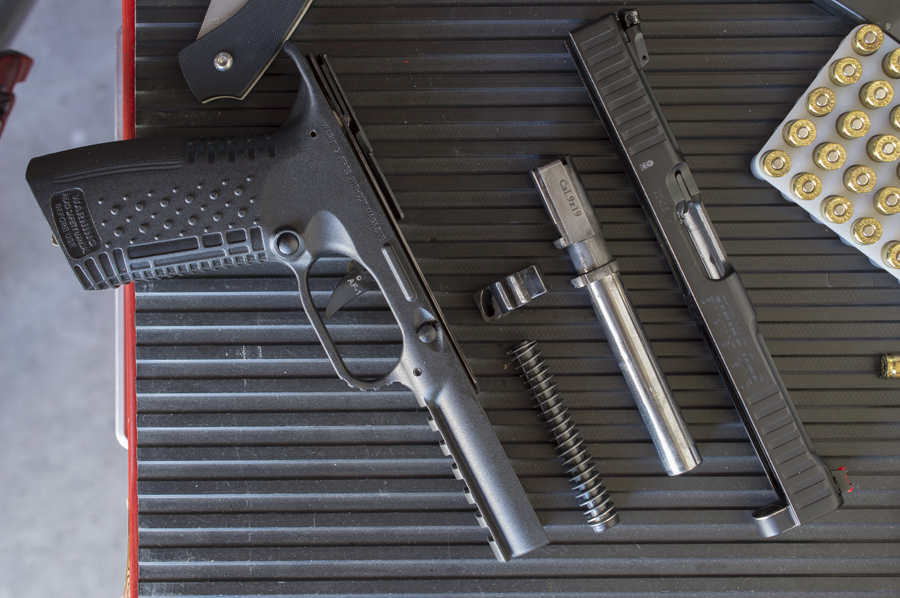
 Ever since Gaston Glock began popularizing the polymer-framed, striker-fired pistol in 1982, we’ve seen dozens of renditions on the theme, all trying to out-Glock all of Glock’s most striking (pun very much intended) feature: Simplicity.
Ever since Gaston Glock began popularizing the polymer-framed, striker-fired pistol in 1982, we’ve seen dozens of renditions on the theme, all trying to out-Glock all of Glock’s most striking (pun very much intended) feature: Simplicity.
The Arsenal Firearms Strike One Speed does not.
Yes, it has a frame made of polymer, with a steel chassis pressed into it. And yes, the slide contains a striker assembly, not unlike that you’d find inside a Glock. But where the Glock design leans on simplicity as a necessity of its “reliability above all else” ethos, the Strike One Speed puts a greater importance on performance, and as such is far more finely made and reasonably more complex. In fact, in the realm of polymer-framed, striker-fired pistols the Strike One Speed is about as far from Gaston Glock’s famous design as you can get.

It’s a very slick system, and in our experience, it definitely works. That it does result in a lower slide profile is plainly obvious, and in our testing there were no hang-ups of any sort, so we’re comfortable calling it reliable. We stopped short of measuring the load-bearing surfaces that comprise the Strike One’s locking lugs but given the abundant quality with which the gun was clearly manufactured we also have no concerns as to the gun’s long-term reliability, either. In fact, for those of us that are mechanically minded, it’s a beautiful system in its operation, and makes for a gun that cycles incredibly smoothly. While a conventional tilting-barrel pistol will usually rattle a bit when unlocked, the Strike One Speed keeps the barrel retained inside the trunnion (which itself is held firmly to the frame via the take-down pin) throughout the firing cycle, and so feels much more monolithic when the slide is manually racked. It’s hard to describe, but it’ll be a familiar sensation to those that are familiar with the way a Beretta 92 handles, and it’s definitely a nicer feeling than the average semi-auto imparts.

On the Strike One Speed the striker block is actuated horizontally, and is installed in the frame, rather than the slide. Visibly identifiable as a small machined piece of steel with a triangular lug, this striker block interfaces with another similarly triangular lug attached to the striker. If the striker is jostled loose the striker block prevents the striker from impacting the primer of a chambered round. Alternatively if the trigger is pulled an action bar (visible in the nearby picture as the small vertical triangular steel stamping) forces the striker block to rotate a few degrees to the right, moving the triangular striker block out of the way, and allowing the striker to travel forward unhindered. So why the triangular shapes? Well, that allows the triangular striker lug to proceed rearward with the slide without the trigger being depressed; it simply shoves the striker block to the right on its way past.

Which brings us to the Strike One Speed’s specific design purpose. While the original Strike One Speed is marketed as a competition gun in the Western world, it’s basically the civilian version of the Strizh, a duty pistol that the Russian Army has reportedly adopted to replace their aged Makarovs. As such the Strike One Speed has many of the aforementioned inherently cool design features aimed at making the slide as low-slung as possible in order to reduce recoil, but is also externally simple, with fixed (and strange) sights and a familiar duty trigger configuration and pull… both features we lamented in our review of the original Strike One. It was an odd juxtaposition of inherent capability and innovation hamstrung by the lowest-common-denominator factor that large-scale, issued duty pistols are typically afflicted by.

And if we’re honest, there’s only one part of the above paragraph that really matters: The sights. The original Strike One’s sights are relatively mundane and, in the case of our previous Strike One tester, colour-matched to the stainless steel slide. That meant we had to find a grey front sight, in a grey rear sight, on a black or white target. Literally, the worst contrasting sight setup imaginable; it didn’t work regardless of what colour your target was. And even worse, while the front sights was dovetailed in place, the rear sight was integral to the slide rear cover. That means you’ll never find replacement sight setups from any of the popular brands for a standard Strike One.
The Strike One Speed, on the other hand, has a very nice adjustable rear sight that’s affixed to the slide via a conventional dovetail. That means it’s probably entirely possible to replace the sights with some form of aftermarket setup and a quick Google search confirmed that options are available to fit fibre optic or tritium rear sights… although offerings are still what we’d classify as “sparse.” But honestly, unless you’re one of those shooters that requires all your pistols to have the exact same sight setup, it’s probably a moot point as the stock sights are very good.

And that probably sums up the entire experience of shooting the Strike One Speed. From the moment you pick it up, it doesn’t feel like a normal gun. The grip is probably the longest modern pistol grip in the world, but the circumference is quite normal; the result of the Strike One’s narrowly double-stacked magazines. Loading the Strike One Speed is insanely easy, as the designers have used some of the real estate inside that insanely long grip to create a huge bevelled magazine well, which works in conjunction with the narrow and tapering magazines to make reloads require about as much finesse as easy as throwing a hot dog down a hallway. You can literally just toss the magazine towards the gun and it’ll probably end up where it needs to be.

It is, however, accurate. It is one of the most accurate pistols that’s ever crossed our desk here… sort of. See, in testing the gun off a rest, we managed to eke out 2” groups at 20 metres from just about every variety of ammo we had available. That’s pretty good, but hardly ground breaking. The big news was that we managed to shoot pretty much the exact same groups unsupported, and we’re not so good that we can claim a rest doesn’t normally help a wee bit! So why does the Strike One Speed perform so well in the hand?

Now that’s not to say it’s perfect. The slide release is low-profile and out of the way but also doesn’t provide the shooter much purchase during reloads. Replacement parts may not be as easy to find. And finally, the grip texture is not aggressive enough, and were we to buy one we’d probably end up stippling it or covering it in sandpaper. But that’d suck, because buying a Strike One Speed will set you back right around $1,400… so maybe we’d go with the sandpaper option, rather than the “I’m just going to use a soldering iron to permanently alter my $1,400 pistol’s polymer frame.”
